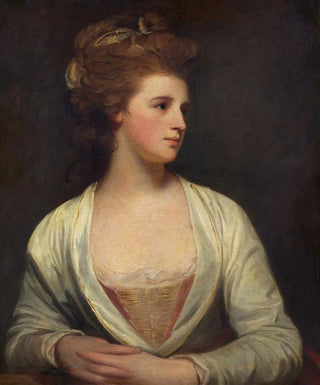Art print | Portrait of a woman believed to be Emily Bertie Pott - George Romney


View from behind

Frame (optional)
Portrait of a woman believed to be Emily Bertie Pott - George Romney – Captivating introduction
The "Portrait of a woman believed to be Emily Bertie Pott" by George Romney is a work that, through its elegance and psychological depth, invites attentive contemplation. The artist, renowned for his ability to capture the beauty and soul of his subjects, succeeds here in transcending a simple portrait to offer a penetrating insight into the personality of the depicted woman. This painting, emblematic of the late 18th century, evokes not only a female figure but also an era where art intertwines with social and cultural identity. The mystery surrounding the identity of the model, often referred to as Emily Bertie Pott, adds an intriguing dimension to the work, prompting viewers to question her story and her role in the society of her time.
Style and uniqueness of the work
Romney's style is distinguished by a delicacy in the treatment of features and meticulous attention to detail. In this portrait, light plays a fundamental role, creating a play of shadows and reflections that imparts unprecedented depth to the woman's face. The colors, subtly nuanced, evoke an atmosphere of softness and serenity. Every brushstroke seems charged with emotion, and the facial expression, both gentle and resolute, reflects deep introspection. The composition, though classical, hints at a modernity that still resonates today, making this work a timeless testament to feminine beauty. The way Romney manages to capture not only the external appearance but also the inner essence of his subject is what makes this art print so unique and captivating.
The artist and his influence
George Romney, born in 1734, is one of the most prominent portraitists of his time. His career, marked by encounters with eminent figures of British society, allowed him to develop a unique style that combines realism with a certain idealization. Influenced by the masters of the past, he was able to incorporate elements of neoclassicism while maintaining a personal touch. His work is not limited to simple representation; he seeks to establish

Matte finish

View from behind

Frame (optional)
Portrait of a woman believed to be Emily Bertie Pott - George Romney – Captivating introduction
The "Portrait of a woman believed to be Emily Bertie Pott" by George Romney is a work that, through its elegance and psychological depth, invites attentive contemplation. The artist, renowned for his ability to capture the beauty and soul of his subjects, succeeds here in transcending a simple portrait to offer a penetrating insight into the personality of the depicted woman. This painting, emblematic of the late 18th century, evokes not only a female figure but also an era where art intertwines with social and cultural identity. The mystery surrounding the identity of the model, often referred to as Emily Bertie Pott, adds an intriguing dimension to the work, prompting viewers to question her story and her role in the society of her time.
Style and uniqueness of the work
Romney's style is distinguished by a delicacy in the treatment of features and meticulous attention to detail. In this portrait, light plays a fundamental role, creating a play of shadows and reflections that imparts unprecedented depth to the woman's face. The colors, subtly nuanced, evoke an atmosphere of softness and serenity. Every brushstroke seems charged with emotion, and the facial expression, both gentle and resolute, reflects deep introspection. The composition, though classical, hints at a modernity that still resonates today, making this work a timeless testament to feminine beauty. The way Romney manages to capture not only the external appearance but also the inner essence of his subject is what makes this art print so unique and captivating.
The artist and his influence
George Romney, born in 1734, is one of the most prominent portraitists of his time. His career, marked by encounters with eminent figures of British society, allowed him to develop a unique style that combines realism with a certain idealization. Influenced by the masters of the past, he was able to incorporate elements of neoclassicism while maintaining a personal touch. His work is not limited to simple representation; he seeks to establish






